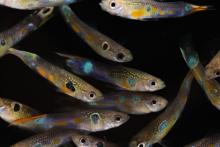Tony Yang has always had a passion for science education. But even he couldn’t have guessed that his love of teaching would one day involve jello.
After graduating from UBC with a General Science degree in 2008, Yang is now pursuing his PhD. His UBC experience has enabled him to couple his interest in science education with his thesis, which explores chemical and biological engineering and microfluidics.
Microfluidics is about controlling the flow and reaction of a small amount of fluids within a tiny area. This inter-disciplinary field has spurred advances in physics, engineering, microtechnology and biotechnology with innovations such as lab-on-a-chip and DNA chips.
So where does the jello come in?
Yang explains that the process of pouring jello into a mold was often used as an analogy to soft-lithography, which is the process typically used to make microfluidic chips out of elastomeric materials.
Professor Eric Lagally, Yang’s supervisor, Yang and fellow PhD student Eric Ouellet worked to create a simple, fun and inexpensive method for teaching microfluidics, and began using jello in their demonstrations during community outreach activities at UBC’s Michael Smith Laboratories (MSL).
“We had so many questions about the experiment: ‘What are the chips made of?’ and ‘What are the applications of this technology?’ It really got people interested in microfluidics,” says Yang.
“As far as we know, we’re the only ones in the world to have come up with a quick, safe and inexpensive way to demonstrate and teach the principles of microfluidics to young students and non-scientists,” says Lagally, who is jointly appointed at the MSL and the Department of Chemical and Biological Engineering, Faculty of Applied Science.
The main materials used to create the molds are foam plates, wooden coffee stir sticks, and double-sided tape. The coffee stir sticks are cut into different shapes and sizes depending on the purpose of the mold and then taped onto a foam plate using double-sided tape, creating a specific pattern.
The chips themselves are made by pouring a liquid mixture of jello and additional gelatin onto the molds and then leaving them to cure for two days in a refrigerator. The chips are then removed from the refrigerator, peeled from the molds, and placed in aluminum dishes for demonstrations.
Using these, teachers can demonstrate concepts such as pressure-driven flow, laminar flows and a jello lab-on-a-chip to detect whether solutions are basic or acidic.
“Microfluidics isn’t just something that scientists are working on in their ‘fancy’ labs. It has real world applications that are evolving all the time,” says Yang.
Yang and his colleagues have started introducing the concept to BC teachers, inviting them to MSL to try the experiments for themselves as part of annual Teacher Professional Development Days.
“The response has been overwhelming,” says Yang. “Several teachers have expressed interest in trying the jello experiment with their students.”
They are also reaching out to students. Through MSL, Yang and his colleagues have provided demonstrations to high school students, and to international UBC Science students, who all had the opportunity to work with the jello chips hands-on.
“Watching the technique being used to teach students is by far the most rewarding part for me,” says Yang. “It gets them excited about scientific research. We’ve found that when students are exposed to science at a young age, they’re more likely to pursue science in post secondary education.”
Yang has acted as a mentor for two grade 10 students who approached MSL asking for lab experience. They were involved in developing the initial jello protocol and experiments.
The approach to teaching has helped the technique find its way into the community. Two grade 11 students who participated in this year’s Greater Vancouver Regional Science Fair used the jello method to simulate cell-trapping experiments. The students modified and improved on the existing technology, so that curved channels can also be made.
“Jello resonates with kids so this work serves as a bridge between young students and scientists” adds Yang. “As microfluidics continues to become an integral part of our daily lives, it’s important to get students excited about this research and also to get them thinking about possible careers in science.”
With files from Lorraine Chan, UBC Public Affairs
Musqueam First Nation land acknowledegement
We honour xwməθkwəy̓ əm (Musqueam) on whose ancestral, unceded territory UBC Vancouver is situated. UBC Science is committed to building meaningful relationships with Indigenous peoples so we can advance Reconciliation and ensure traditional ways of knowing enrich our teaching and research.
Learn more: Musqueam First Nation
Faculty of Science
Office of the Dean, Earth Sciences Building2178–2207 Main Mall
Vancouver, BC Canada
V6T 1Z4


